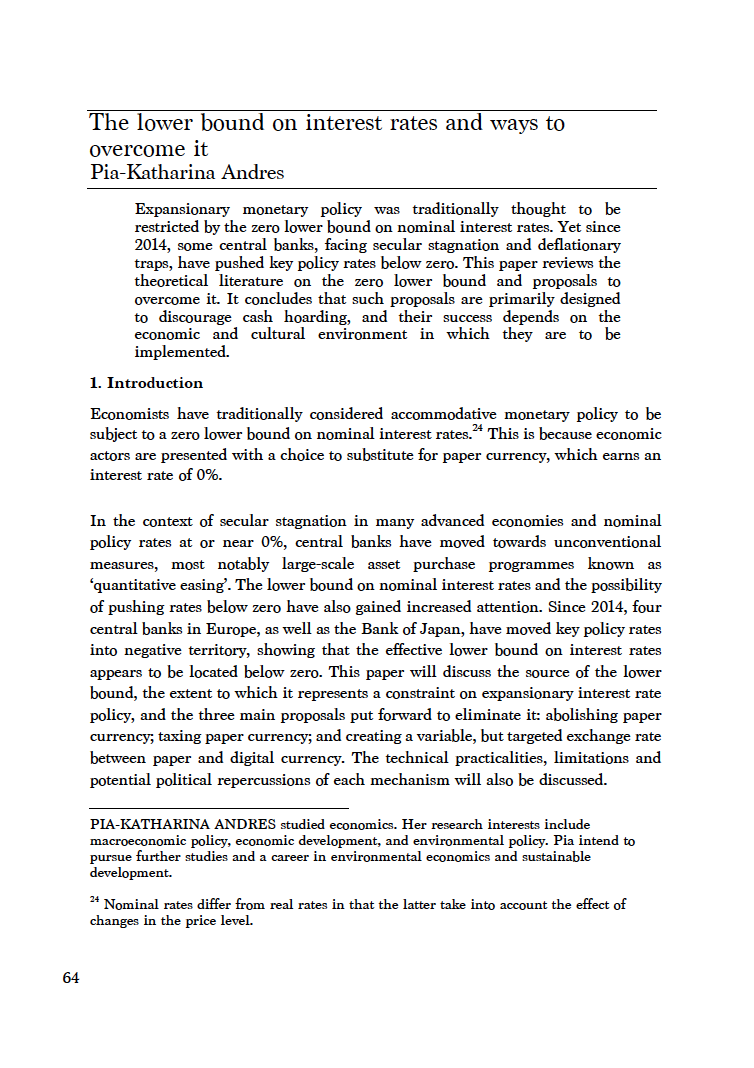The lower bound on interest rates and ways to overcome it
DOI:
https://doi.org/10.36399/GroundingsUG.10.188Keywords:
Interest rates, Lower bounds, Monetary Policy, Cash hoarding, Central bankingAbstract
Expansionary monetary policy was traditionally thought to be restricted by the zero lower bound on nominal interest rates. Yet since 2014, some central banks, facing secular stagnation and deflationary traps, have pushed key policy rates below zero. This paper reviews the theoretical literature on the zero lower bound and proposals to overcome it. It concludes that such proposals are primarily designed to discourage cash hoarding, and their success depends on the economic and cultural environment in which they are to be implemented.
References
Agarwal, R. and M. Kimball (2015): “Breaking through the zero lower bound,” IMF Working Paper 15/224.
Bech, M. and A. Malkhozov (2016): “How have central banks implemented negative policy rates?” BIS Quarterly Review, March 2016.
Borio, C. and P. Disyatat (2009): “Unconventional monetary policies: an appraisal,” BIS Working Paper 292.
Buiter, W. H. (2009): “Negative Nominal Interest Rates: Three ways to overcome the zero lower bound,” NBER Working Paper 15118.
Buiter, W. H. and N. Panigirtzoglou (1999): “Liquidity traps: how to avoid them and how to escape them,” NBER Working Paper 7245.
Eisler, R. (1932): Stable Money: The Remedy for the Economic World Crisis, London: The Search Publishing.
Fisher, I. (1933): Stamp Scrip, New York: Adelphi.
Gesell, S. and P. Pye (1958): The natural economic order, London: Owen.
Gimdal, G. and C. Karakas (2016): “Secular stagnation and the euro area,” European Parliamentary Research Service, pE 573.972, Briefing, February 2016.
Goodfriend, M. (2000): “Overcoming the Zero Bound on Interest Rate Policy,” Journal of Money, Credit and Banking, 32, 1007–1035.
Hannon, P. (2016): “Eurozone Slides Back Into Deflation,” The Wall Street Journal — Economy — Europe Economy, 18 May 2016, available online at https://goo.gl/A2NAIU. Accessed 7 January 2017.
Heller, N. (2016): “Imagining a cashless world,” The New Yorker — Letter from Stockholm, 10 October 2016, available online at https://goo.gl/0atjBo. Accessed 10 January 2017.
Hicks (1937): “Mr. Keynes and the “Classics”; A Suggested Interpretation,” Econometrica, 5, 147–159.
Keynes, J. M. (1936/1939): The General Theory of Employment, Interest and Money, London: Macmillan.
Kimball, M. (2013): “A Minimalist Implementation of Electronic Money,” Confessions of a Supply-Side Liberal, 20 May 2013, available online at https://goo.gl/o2XpVa. Accessed 10 January 2017.
Kimball, M. S. (2015): “Negative Interest Rate Policy as Conventional Monetary Policy,” National Institute Economic Review, 234, R5–R14.
Mayger, J. and C. Anstey (2016): “Cash Is Still King in Japan, and That Could Be a Problem for the BOJ,” Bloomberg Markets, 8 November 2016, available online at https://goo.gl/LJRzda. Accessed 9 January 2017.
Neate, R. (2016): “US Federal Reserve raises interest rates for second time since 2008 crisis,” The Guardian — Business, 14 December 2016, available online at https://goo.gl/RvhtoB. Accessed 5 January 2017.
Rogoff, K. (2016): The Curse of Cash, Princeton: University Press.
Sveriges Riksbank (2016): “The Swedish Financial Market,” Sveriges Riksbank Publications, Stockholm, August 2016.
Yates, T. (2002): “Monetary Policy and the Zero Bound to Interest Rates: A Review,” European Central Bank Working Paper 190.

Downloads
Published
Issue
Section
License
Copyright (c) 2017 Pia-Katharina Andres

This work is licensed under a Creative Commons Attribution 4.0 International License.
The CC BY 4.0 license is a Creative Commons license. This is a non-copyleft free license that is good for art and entertainment works, and educational works. It is compatible with all versions of the GNU GPL; however, like all CC licenses, it should not be used on software. People are free to: Share — copy and redistribute the material in any medium or format; Adapt — remix, transform, and build upon the material for any purpose, even commercially. The licensor cannot revoke these freedoms as long as you follow the license terms. But they must conform to the following terms: Attribution — You must give appropriate credit, provide a link to the license, and indicate if changes were made. You may do so in any reasonable manner, but not in any way that suggests the licensor endorses you or your use. No additional restrictions — You may not apply legal terms or technological measures that legally restrict others from doing anything the license permits.
Please check individual article PDF copies to see if any additional restrictions apply.







